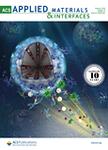版权所有:内蒙古大学图书馆 技术提供:维普资讯• 智图
内蒙古自治区呼和浩特市赛罕区大学西街235号 邮编: 010021

作者机构:Hubei Univ Coll Chem & Chem Engn Minist Educ Key Lab Synth & Applicat Organ Funct MolCollabora Wuhan 430062 Peoples R China Tianjin Univ Tradit Chinese Med Sch Chinese Mat Med Tianjin Key Lab Therapeut Subst Tradit Chinese Med Tianjin 301617 Peoples R China Chinese Pharmacopoeia Commiss Beijing 100061 Peoples R China Beijing Normal Univ Adv Interdisciplinary Inst Environm & Ecol Guangdong Prov Key Lab Wastewater Informat Anal & Zhuhai 519087 Peoples R China
出 版 物:《ACS APPLIED MATERIALS & INTERFACES》 (ACS Appl. Mater. Interfaces)
年 卷 期:2025年第17卷第3期
页 面:5223-5231页
核心收录:
学科分类:0817[工学-化学工程与技术] 08[工学] 0805[工学-材料科学与工程(可授工学、理学学位)]
基 金:National Natural Science Foundation of China [21901067, 22101077, 82374033] National Natural Science Foundation of China [2021CFB092] Youth Foundation of Hubei Province Ministry of Human Resource and Social Security of China
主 题:multicomponent gel coassembly herbal medicine self-healing antibacterial activity
摘 要:Chinese herbal medicine has offered a great treasure for discovering intrinsically bioactive low molecular weight gelators (LMWGs). Herein, the two-component hydrogels comprising glycyrrhizic acid (GA) and puerarin (PUE), the primary bioactive components, respectively, from herbs Glycyrrhiza uralensis Fisch and Pueraria lobata are successfully prepared. Combined spectroscopic characterizations reveal that hydrogen bonds are formed between GA and PUE molecules, which further drives the growth of nanofiber assemblies into gel networks. Importantly, micromorphological observation by scanning electron microscopy (SEM), synchrotron small-angle X-ray scattering (SAXS), and molecular dynamic simulation suggest that a coassembly pathway is involved in the gelling process. Such two-component hydrogels exhibit good injectable, self-healing, and adhesive properties. Interestingly, the mixed GA-PUE hydrogels demonstrate a more efficient and selective antibacterial activity toward S. aureus instead of E. coli, and a PUE ratio-dependent antibacterial activity toward S. aureus is also observed. Our work highlights that CHM-derived LMWGs can provide a scaffold for developing multicomponent hydrogels, which may afford novel and distinct properties compared with their individual ones. It is assumed that more multicomponent supramolecular hydrogels derived from CHM would appear to better address the challenges, particularly in the biomedical field.